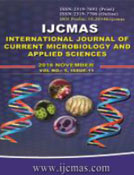


 National Academy of Agricultural Sciences (NAAS)
National Academy of Agricultural Sciences (NAAS)

|
PRINT ISSN : 2319-7692
Online ISSN : 2319-7706 Issues : 12 per year Publisher : Excellent Publishers Email : editorijcmas@gmail.com / submit@ijcmas.com Editor-in-chief: Dr.M.Prakash Index Copernicus ICV 2018: 95.39 NAAS RATING 2020: 5.38 |
The present work was directed to study the possibility of using Amplitude Modulated Waves (AMW) in food preservation. The effect of AMW on the growth and, in vitro, production of aflatoxins by some fungal species isolated from stored kidney bean seeds was investigated. Eight fungal genera comprising 11 species were isolated from 4 months stored kidney bean seeds. Genus aspergillus was the most dominant followed by Pencillium puberulum (RD. 62.8% and 19.2% of the total count, respectively). Aspergillus fndFlavus (A. fndFlavus) was the incomparable highly frequent species on the isolation plates. It constituted 35.6% of the total count. Only two isolates of A. flavus (I1 and I2) were found to produce aflatoxins in vitro, of the type B2, G1 and G2 in variable amounts. Exposure of the two isolates to amplitude modulated waves (AMW) for two hours at different frequencies inhibited spore germination and mycelia dry weight, irrespective of the wave frequency. The greatest inhibition was recorded at frequency of 10 Hz which completely suppressed the production of all types of aflatoxins. RAPD-PCR molecular analysis for aflatoxins producing fungi revealed relative changes in the position and number of some bands in DNA profile of both isolates, after treating with AMW at 10 Hz. Cluster analyses for PCR products revealed a decreased genetic similarity level between the two exposed isolates and their respective non-treated controls.
 |
 |
 |
 |
 |